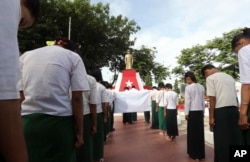A nationwide drive in Myanmar to build statues of independence hero General Aung San risks further alienating ethnic minority groups in the country, and could impact the ruling party’s performance in upcoming elections, analysts say.
Aung San, who is the father of National League for Democracy (NLD) leader Aung San Suu Kyi, is popular in large parts of the country, particularly in the Bamar-majority heartlands. However, in the ethnic minority-dominated border regions, critics say the statues are a sign of continued “Burmanization” and that they would prefer to see statues depicting heroes that belong to their own ethnic group.
“The government should consult with [local people] if they want to build the [Aung San] statue there,” said Mie Mie, a civil society leader in Kayah State, where widespread protests have been held against a planned Aung San statue. “If we’re going to have statues, it should be of heroes in our state.”
Ethnic minorities have long been distrustful of a central government dominated by the Bamar-majority. Shortly before then-Burma gained independence from the British in 1948, members of ethnic minority groups signed a deal that would provide them with “full autonomy,” but the agreement was never fulfilled.
The distrust was heightened over decades of military rule, particularly amid brutal fighting between the Bamar-dominated Tatmadaw and ethnic armed groups operating in the border regions. Despite some moves towards peace, much of that fighting continues today.
After the NLD convincingly won the 2015 general election, many ethnic minorities hoped the situation would change, but distrust has continued to grow.
After coming to power, Aung San Suu Kyi promised to make the peace process a priority, but has made limited progress. Meanwhile, many members of ethnic minority groups now regard Aung San Suu Kyi as being closely aligned with the Tatmadaw.
Statue building
There appears to have been an uptick in the number of Aung San statues being built nationwide since the NLD came to power. In June 2017, the country’s largest Aung San bust was unveiled in Mandalay, while several others have appeared in ethnic minority areas.
It’s not clear who is behind the statue drive, and a spokesperson for the NLD could not be reached for comment.
The statues have not been universally welcomed, however. In July, thousands of people protested a planned statue in Kayah State, then weeks later another Aung San statue in Myitkyina, the capital of Kachin State, was vandalized.
Salai Holy, editor of The Chinland Post in Chin State, told VOA the state government is planning to construct at least two Aung San statues there.
Holy said most local residents were against the statues because they believed funds would be better spent on developing one of Myanmar’s poorest states.
“That money should be used for the town’s development,” he said. “Water is not sufficient, health care is not sufficient and the roads are not good. So instead of using that budget to build the statue, that money should be used for these things.”
Another statue is planned in Hakha, the state capital, and Holy said a decision to do so had not included consultation with the local communities. He said some people wanted to see an Aung San statue in the town, but that most were against it.
“Those who disagree say that if we are going to build a statue, then build one of our heroes of Chin State,” he said. “It doesn’t mean that we don’t respect Aung San, but what we really want that money to be used for development purposes. There is so much to be done,” he said.
“But if it is going to be used to build a statue, then use it to build them of Chin heroes. We have many Chin heroes,” he added.
Political ramifications
Analysts say the NLD’s alienation of ethnic minorities could have a detrimental impact on the party’s performance in by-elections scheduled to take place in November, and the 2020 general election.
In early 2017, weeks before that year’s by-election, large-scale protests were held in Chaungzon in Mon State after the government voted to name a bridge there after Aung San. Residents wanted the bridge to be given a name more closely associated with Mon identity. In the by-election, held in April 2017, the NLD lost to the military-linked Union Solidarity and Development Party.
Mi Kun Chan Non, vice chairperson of the Mon Women’s Organization, said the decision regarding the bridge had impacted the by-election result.
“We see this [statue issue] as Burmanization,” she told VOA. “We have lots of leaders who are important for the Mon people, and it’s the same for people in Kayah State. They request a statue of their own leaders, otherwise it’s seen as Burmanization.”










